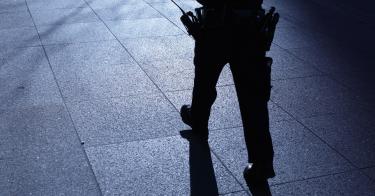Speaking to a supportive crowd at the national convention of the Fraternal Order of Police, Attorney General Jeff Sessions announced that President Donald Trump would shortly sign an executive order—which he has now done—rolling back limitations that had been placed by the Obama administration on the ability of the military to transfer excess equipment to civilian law enforcement authorities.
Sessions told the crowd:
President Trump is serious about this mission. He is doing all he can to restore law and order and support our police across America. And that is why, today, I am here to announce that President Trump is issuing an executive order that will make it easier to protect yourselves and your communities. He is rescinding restrictions from the prior administration that limited your agencies’ ability to get equipment through federal programs, including life-saving gear like Kevlar vests and helmets and first responder and rescue equipment like what they’re using in Texas right now.
The so-called “1033 program” was created by Congress as part of the National Defense Authorization Act, which was signed into law in 1996 by President Bill Clinton. This program allowed the Defense Department to transfer excess military equipment to civilian law enforcement agencies.
As of 2014, approximately 8,000 local law enforcement agencies have participated in the program resulting in more than $5.4 billion in previously purchased, surplus military gear—including computers, air conditioners, clothing, medical supplies, flashlights, ammunition, rifles, helmets, helicopters, and armored vehicles—being recycled for domestic law enforcement purposes.
In the wake of the riots in Ferguson, Missouri in August 2014 following the death of Michael Brown, President Barack Obama signed Executive Order 13688, which established a Law Enforcement Equipment Working Group.
That group subsequently issued a report recommending that the military be prohibited from transferring certain equipment, such as camouflage uniforms, high-caliber weapons, grenade launchers, and armored vehicles, with additional controls placed on the transfer of other equipment.
At the time he signed the executive order, Obama stated, “We’ve seen how militarized gear can sometimes give people a feeling like there’s an occupying force as opposed to a force that’s part of the community that’s protecting and serving them.”
He continued, “It can alienate and intimidate local residents and send the wrong message.”
While there have been occasions where law enforcement officials have overreacted and have unwittingly inflamed a situation, it is also true that there are occasions where law enforcement authorities need such equipment in order to protect the public—for instance, during terrorist attacks, search-and-rescue operations, or in the wake of natural disasters.
Equipment provided through this program is currently being deployed in Texas to save lives in the aftermath of Hurricane Harvey. Such equipment also resulted in lives saved during police operations in response to the terrorist attacks in San Bernardino in 2015 and at the Pulse nightclub in Orlando in 2016.
A study released earlier this month entitled, “Police Officer on the Frontline or a Soldier: The Effect of Police Militarization on Crime,” concludes that a “10 percent increase in the total value of military aid [given to a community] leads to a decrease of 5.9 crimes per 100,000 population” and that such aid is associated with a reduction in complaints about crime from local citizens.
The authors of this study estimate that $5,800 worth of military gear can result in savings to society (based on the average cost of a crime) of $112,000, thereby making military aid “a very inexpensive crime-reducing tool” compared to other types of law enforcement expenditures.
Obama certainly had a point that law enforcement authorities must be vigilant as to how and when they deploy such equipment, and should guard against overly aggressive approaches that might unduly and unnecessarily alarm the public.
Law enforcement officers should establish guidelines governing such usage and should be adequately trained in using it.
Nonetheless, one cannot deny that when law enforcement authorities need such equipment, they really, really need it—and we need them to have it. As Sessions stated in his remarks to the Fraternal Order of Police, referring to the restrictions imposed by the Obama administration:
Those restrictions went too far. We will not put superficial concerns above public safety. All you need to do is turn on a TV right now to see that for Houstonians this isn’t about appearances, it’s about getting the job done and getting everyone to safety. The executive order the president will sign today will ensure that you can get the lifesaving gear that you need to do your job and send a strong message that we will not allow criminal activity, violence, and lawlessness to become the new normal. And we will save taxpayer money in the meantime.
This piece originally appeared in The Daily Signal




